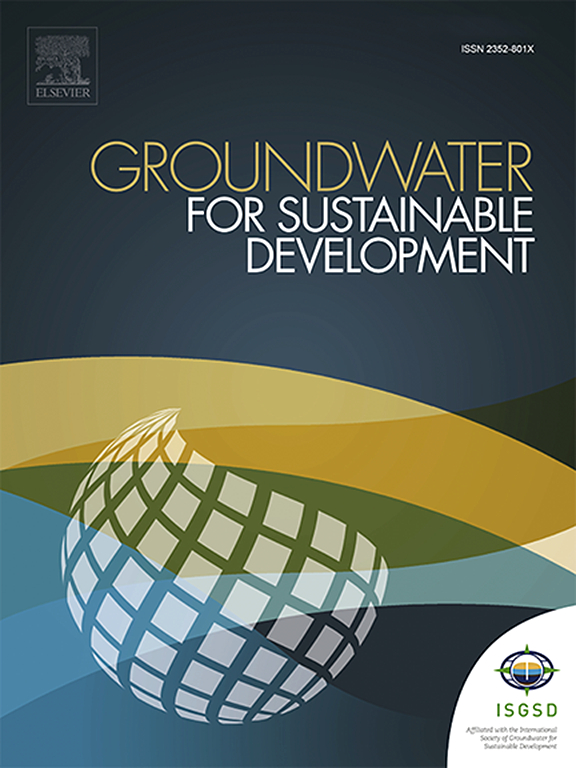Assessing the contribution of managed aquifer recharge programs on groundwater storage in the Ramganga basin
IF 4.9
Q2 ENGINEERING, ENVIRONMENTAL
引用次数: 0
Abstract
Groundwater, which supports nearly two-thirds of irrigation and underpins food security in India, faces depletion due to unsustainable abstraction. Managed aquifer recharge (MAR) programs, which replenish aquifers during periods of surplus surface water, have emerged as a national strategy to bolster groundwater security. This study evaluates the contribution of government-led aquifer recharge programs to groundwater storage in the alluvial aquifers of the Ramganga basin, whilst taking account of factors such as climate variability and agricultural water demand. The analysis, drawing on district-level MAR development data, field monitoring of recharge structures, and trends in rainfall, irrigation, and groundwater levels, reveals that MAR initiatives have a positive impact on groundwater storage. However, at their current scale, their contribution is modest accounting for an estimated 2.5–7.5 % of rainfall-recharge in 2023. Thus, groundwater levels continue to decline across districts, with average annual depletion rates of 0.21–0.29 m/year, indicating that current MAR contributions remain insufficient to counter the supply-demand imbalance. Scaling of MAR has been assessed to require >40,000 additional recharge ponds. Moreover, the recharge efficiency of existing structures, averaging 48 mm/day, falls well below that of optimized MAR systems that incorporate recharge wells. Beyond supply-side measures, this study highlights the need for integrated demand management strategies in the Ganges basin. It underscores the pressing need for a comprehensive, science-based approach to MAR implementation, coupled with demand-side interventions, to ensure sustainable groundwater management.

评估管理含水层补给计划对Ramganga盆地地下水储存的贡献
地下水支撑着印度近三分之二的灌溉和粮食安全,但由于不可持续的抽取,地下水面临枯竭。管理含水层补给(MAR)计划,即在地表水过剩期间补充含水层,已成为加强地下水安全的国家战略。本研究在考虑气候变化和农业用水需求等因素的同时,评估了政府主导的含水层补给计划对Ramganga盆地冲积含水层地下水储存的贡献。该分析利用了地区一级MAR发展数据、补给结构的实地监测以及降雨、灌溉和地下水位的趋势,表明MAR举措对地下水储存有积极影响。然而,以目前的规模来看,它们的贡献并不大,约占2023年降雨量补给的2.5 - 7.5%。因此,各地区的地下水位继续下降,年平均枯竭率为0.21-0.29米/年,表明目前的MAR贡献仍不足以抵消供需不平衡。据评估,MAR的结垢需要40,000个额外的补给池。此外,现有结构的回灌效率平均为48毫米/天,远低于优化后的MAR系统,其中包括回灌井。除了供应方面的措施外,本研究还强调了恒河流域综合需求管理战略的必要性。它强调迫切需要一种全面的、以科学为基础的方法来实施MAR,加上需求方面的干预措施,以确保可持续的地下水管理。
本文章由计算机程序翻译,如有差异,请以英文原文为准。
求助全文
约1分钟内获得全文
求助全文
来源期刊

Groundwater for Sustainable Development
Social Sciences-Geography, Planning and Development
CiteScore
11.50
自引率
10.20%
发文量
152
期刊介绍:
Groundwater for Sustainable Development is directed to different stakeholders and professionals, including government and non-governmental organizations, international funding agencies, universities, public water institutions, public health and other public/private sector professionals, and other relevant institutions. It is aimed at professionals, academics and students in the fields of disciplines such as: groundwater and its connection to surface hydrology and environment, soil sciences, engineering, ecology, microbiology, atmospheric sciences, analytical chemistry, hydro-engineering, water technology, environmental ethics, economics, public health, policy, as well as social sciences, legal disciplines, or any other area connected with water issues. The objectives of this journal are to facilitate: • The improvement of effective and sustainable management of water resources across the globe. • The improvement of human access to groundwater resources in adequate quantity and good quality. • The meeting of the increasing demand for drinking and irrigation water needed for food security to contribute to a social and economically sound human development. • The creation of a global inter- and multidisciplinary platform and forum to improve our understanding of groundwater resources and to advocate their effective and sustainable management and protection against contamination. • Interdisciplinary information exchange and to stimulate scientific research in the fields of groundwater related sciences and social and health sciences required to achieve the United Nations Millennium Development Goals for sustainable development.
 求助内容:
求助内容: 应助结果提醒方式:
应助结果提醒方式:


